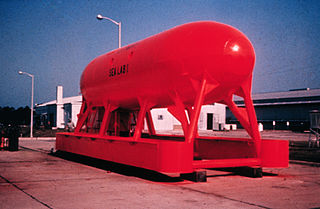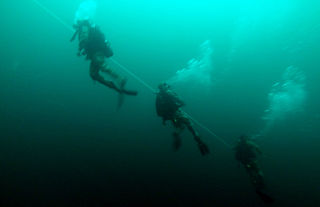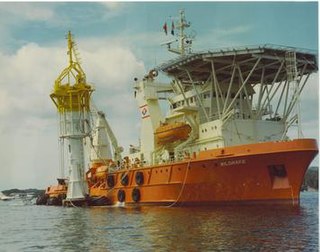
Surface-supplied diving is diving using equipment supplied with breathing gas using a diver's umbilical from the surface, either from the shore or from a diving support vessel, sometimes indirectly via a diving bell. This is different from scuba diving, where the diver's breathing equipment is completely self-contained and there is no link to the surface. The primary advantages of conventional surface supplied diving are lower risk of drowning and considerably larger breathing gas supply than scuba, allowing longer working periods and safer decompression. Disadvantages are the absolute limitation on diver mobility imposed by the length of the umbilical, encumbrance by the umbilical, and high logistical and equipment costs compared with scuba. The disadvantages restrict use of this mode of diving to applications where the diver operates within a small area, which is common in commercial diving work.

Saturation diving is diving for periods long enough to bring all tissues into equilibrium with the partial pressures of the inert components of the breathing gas used. It is a diving mode that reduces the number of decompressions divers working at great depths must undergo by only decompressing divers once at the end of the diving operation, which may last days to weeks, having them remain under pressure for the whole period. A diver breathing pressurized gas accumulates dissolved inert gas used in the breathing mixture to dilute the oxygen to a non-toxic level in their tissues, which can cause decompression sickness if permitted to come out of solution within the body tissues; hence, returning to the surface safely requires lengthy decompression so that the inert gases can be eliminated via the lungs. Once the dissolved gases in a diver's tissues reach the saturation point, however, decompression time does not increase with further exposure, as no more inert gas is accumulated.

A diving bell is a rigid chamber used to transport divers from the surface to depth and back in open water, usually for the purpose of performing underwater work. The most common types are the open-bottomed wet bell and the closed bell, which can maintain an internal pressure greater than the external ambient. Diving bells are usually suspended by a cable, and lifted and lowered by a winch from a surface support platform. Unlike a submersible, the diving bell is not designed to move under the control of its occupants, nor to operate independently of its launch and recovery system.

A diving support vessel is a ship that is used as a floating base for professional diving projects. Basic requirements are the ability to keep station accurately and reliably throughout a diving operation, often in close proximity to drilling or production platforms, for positioning to degrade slowly enough in deteriorating conditions to recover divers without excessive risk, and to carry the necessary support equipment for the mode of diving to be used.

SEALAB I, II, and III were experimental underwater habitats developed by the United States Navy in the 1960s to prove the viability of saturation diving and humans living in isolation for extended periods of time. The knowledge gained from the SEALAB expeditions helped advance the science of deep sea diving and rescue, and contributed to the understanding of the psychological and physiological strains humans can endure.

A diving chamber is a vessel for human occupation, which may have an entrance that can be sealed to hold an internal pressure significantly higher than ambient pressure, a pressurised gas system to control the internal pressure, and a supply of breathing gas for the occupants.

Diver rescue, following an accident, is the process of avoiding or limiting further exposure to diving hazards and bringing a diver to a place of safety. A safe place is often a place where the diver cannot drown, such as a boat or dry land, where first aid can be administered and from which professional medical treatment can be sought. In the context of surface supplied diving, the place of safety for a diver with a decompression obligation is often the diving bell.

Underwater diving, as a human activity, is the practice of descending below the water's surface to interact with the environment. It is also often referred to as diving, an ambiguous term with several possible meanings, depending on context. Immersion in water and exposure to high ambient pressure have physiological effects that limit the depths and duration possible in ambient pressure diving. Humans are not physiologically and anatomically well adapted to the environmental conditions of diving, and various equipment has been developed to extend the depth and duration of human dives, and allow different types of work to be done.

Commercial offshore diving, sometimes shortened to just offshore diving, generally refers to the branch of commercial diving, with divers working in support of the exploration and production sector of the oil and gas industry in places such as the Gulf of Mexico in the United States, the North Sea in the United Kingdom and Norway, and along the coast of Brazil. The work in this area of the industry includes maintenance of oil platforms and the building of underwater structures. In this context "offshore" implies that the diving work is done outside of national boundaries. Technically it also refers to any diving done in the international offshore waters outside of the territorial waters of a state, where national legislation does not apply. Most commercial offshore diving is in the Exclusive Economic Zone of a state, and much of it is outside the territorial waters. Offshore diving beyond the EEZ does also occur, and is often for scientific purposes.

An emergency ascent is an ascent to the surface by a diver in an emergency. More specifically, it refers to any of several procedures for reaching the surface in the event of an out-of-air emergency, generally while scuba diving.

The history of underwater diving starts with freediving as a widespread means of hunting and gathering, both for food and other valuable resources such as pearls and coral, By classical Greek and Roman times commercial applications such as sponge diving and marine salvage were established, Military diving also has a long history, going back at least as far as the Peloponnesian War, with recreational and sporting applications being a recent development. Technological development in ambient pressure diving started with stone weights (skandalopetra) for fast descent. In the 16th and 17th centuries diving bells became functionally useful when a renewable supply of air could be provided to the diver at depth, and progressed to surface supplied diving helmets—in effect miniature diving bells covering the diver's head and supplied with compressed air by manually operated pumps—which were improved by attaching a waterproof suit to the helmet and in the early 19th century became the standard diving dress.

The Wildrake diving accident was an incident in Scotland in August 1979 that killed two American commercial divers. During a routine dive in the East Shetland Basin of the North Sea, the diving bell of the diving support vessel MS Wildrake became separated from its main lift wire at a depth of over 160 metres (520 ft). Although the bell was eventually recovered by Wildrake, its two occupants, 32-year-old Richard Arthur Walker and 28-year-old Victor Francis "Skip" Guiel Jr., died of hypothermia. The accident resulted in extensive subsequent litigation and led to important safety changes in the diving industry.
The Thistle SALM was a tanker loading facility that allowed oil from the Thistle oilfield to be transported to land where a submarine export pipeline did not yet exist. It was also the site of the August 8, 1979 Wildrake diving accident that killed two divers. and the January 21, 1981 Stena Seaspread diving accident (non-fatal).
The Star Canopus diving accident was an incident in Scotland in November 1978 that killed two British commercial divers. During a routine dive beside the Beryl Alpha platform in the North Sea, the diving bell of the diving support vessel MS Star Canopus was lost when its main lift wire, life support umbilical, and guide wires were severed by an anchor chain of the semi-submersible Haakon Magnus. The bell dropped to the seabed at a depth of over 100 metres (330 ft). Its two occupants, 25-year-old Lothar Michael Ward and 28-year-old Gerard Anthony "Tony" Prangley, were unable to release the bell's drop weight in order to return to the surface because it was secured to the bell frame with secondary locking pins. Since there was not a bell stage to keep the bottom door of the bell off the seabed, the divers could not exit the bell to release the pins. Despite the efforts of three rescue vessels – Intersub 4, Tender Carrier, and Uncle John – the bell was not recovered for over thirteen hours, by which time Ward and Prangley had died of hypothermia and drowning.

The Drill Master diving accident was an incident in Norway in January 1974 that claimed the lives of two Ocean Systems commercial divers. During a two-man dive from the North Sea rig Drill Master, the diving bell's drop weight was accidentally released, causing the bell to surface from a depth of 320 feet (98 m) with its bottom door open and drag the diver working outside through the water on his umbilical. The two divers, Per Skipnes and Robert John Smyth, both died from rapid decompression and drowning. The accident was caused by instructions aboard Drill Master which had not been updated when the bell system was modified and which stated that a valve should be closed during the dive which should have been open.
The Waage Drill II diving accident occurred on 9 September 1975, when two divers died of heatstroke after the chamber they were in was inadvertently pressurised with helium gas.

Surface supplied diving skills are the skills and procedures required for the safe operation and use of surface-supplied diving equipment. Besides these skills, which may be categorised as standard operating procedures, emergency procedures and rescue procedures, there are the actual working skills required to do the job, and the procedures for safe operation of the work equipment other than diving equipment that may be needed.
Diving procedures are standardised methods of doing things that are commonly useful while diving that are known to work effectively and acceptably safely. Due to the inherent risks of the environment and the necessity to operate the equipment correctly, both under normal conditions and during incidents where failure to respond appropriately and quickly can have fatal consequences, a set of standard procedures are used in preparation of the equipment, preparation to dive, during the dive if all goes according to plan, after the dive, and in the event of a reasonably foreseeable contingency. Standard procedures are not necessarily the only courses of action that produce a satisfactory outcome, but they are generally those procedures that experiment and experience show to work well and reliably in response to given circumstances. All formal diver training is based on the learning of standard skills and procedures, and in many cases the over-learning of the skills until the procedures can be performed without hesitation even when distracting circumstances exist. Where reasonably practicable, checklists may be used to ensure that preparatory and maintenance procedures are carried out in the correct sequence and that no steps are inadvertently omitted.

A diving team is a group of people who work together to conduct a diving operation. A characteristic of professional diving is the specification for minimum personnel for the diving support team. This typically specifies the minimum number of support team members and their appointed responsibilities in the team based on the circumstances and mode of diving, and the minimum qualifications for specified members of the diving support team. The minimum team requirements may be specified by regulation or code of practice. Some specific appointments within a professional dive team have defined competences and registration may be required.

MS Wildrake/Holger Dane/NSS Felinto Perry (K-11) is a motor diving vessel originally built and used by Norwegian Company. She was renamed Holger Dane after being sold to Denmark and finally NSS Felinto Perry (K-11) in the Brazilian Navy as a submarine relief ship from the Brazilian Navy. It is equipped to support diving, fire fighting and rescue of submarines.
















